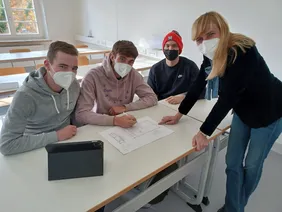The toilets are damaged, a toilet seat is missing. The plaster is trickling from the walls and several windows are smashed. The Tsumkwe community centre is not in good condition. Students at the new Neuburg Campus, the branch of Technische Hochschule Ingolstadt (THI), want to change that. They are currently working on an interdisciplinary and interdisciplinary renovation package over the entire first semester, which is to be sent to Namibia at the beginning of next year. It should contain not only the plans for the building structure, but also structural design, cost estimates and much more - in short, everything that is necessary for the renovation of a building.
Prof. Dr. Jana Bochert, head of the Industrial Engineering and Construction programme, landed the "contract". The THI has been in contact with Namibia for a long time through the "Proceed" research project. Scientists in Tsumkwe are investigating and analysing so-called mini-grids, island grid systems for energy supply, because the community is so remote that it cannot be connected to the national power grid. In the course of this, the idea came up to also provide help from Germany for the repair of the community centre.
This is what practical relevance at the THI looks like
For the students, this offers a unique opportunity to be confronted with a real assignment right at the beginning of their studies. Where others merely work out fictitious ideas, the students of the new THI degree programme can gain practical experience. "You learn things with it not just to pass an exam, but to be able to apply what you have learned in a concrete way," enthuses student Sara Avdic. Together with her fellow students, she was already able to give free rein to creativity in the first week of her studies. "I wanted them to just develop it," Rainer Strauß explains the idea behind it. The Stuttgart architect teaches building construction. The result was four project proposals, which the students presented to a jury and from which a design was derived in the end. This is now being pursued - with everything that goes with it.
The students not only have to think about what needs to be preserved or renewed in the building, but also about the local conditions and the culture of the people. What about the water and sewage supply? What materials are used in construction? What is the condition of the roads and can work materials be transported there at all? If so, at what price? And above all: how do the people live there, which German achievements do they accept and which do they not? Not the water-flushed toilet, for example.
Engaging with the conditions and culture of the local people
"You develop a personal connection to the project," says student Maxi Gottschall, citing one of the advantages of the interdisciplinary concept. Again and again in class, the bridge is built to German building regulations, DIN standards, building materials and much more. What foundations are there and which is best suited for the Namibian community centre? What is the best way to seal it? How do you deal with clay as a building material?
In the end, there should be a redevelopment proposal that offers the people of Tsumkwe an attractive contact point for celebrations and events, a social meeting place with a small kitchenette, a football pitch and a shady veranda in front of the door. In short, a place where people can come together and feel comfortable. "If we can do that, we will have achieved a lot and our students will have learned a lot," is how Prof. Dr. Jana Bochert sums it up.


![[Translate to English:] Logo Akkreditierungsrat: Systemakkreditiert](/fileadmin/_processed_/2/8/csm_AR-Siegel_Systemakkreditierung_bc4ea3377d.webp)








![[Translate to English:] Logo IHK Ausbildungsbetrieb 2023](/fileadmin/_processed_/6/0/csm_IHK_Ausbildungsbetrieb_digital_2023_6850f47537.webp)


